1998 PONTIAC BONNEVILLE fog light
[x] Cancel search: fog lightPage 6 of 395
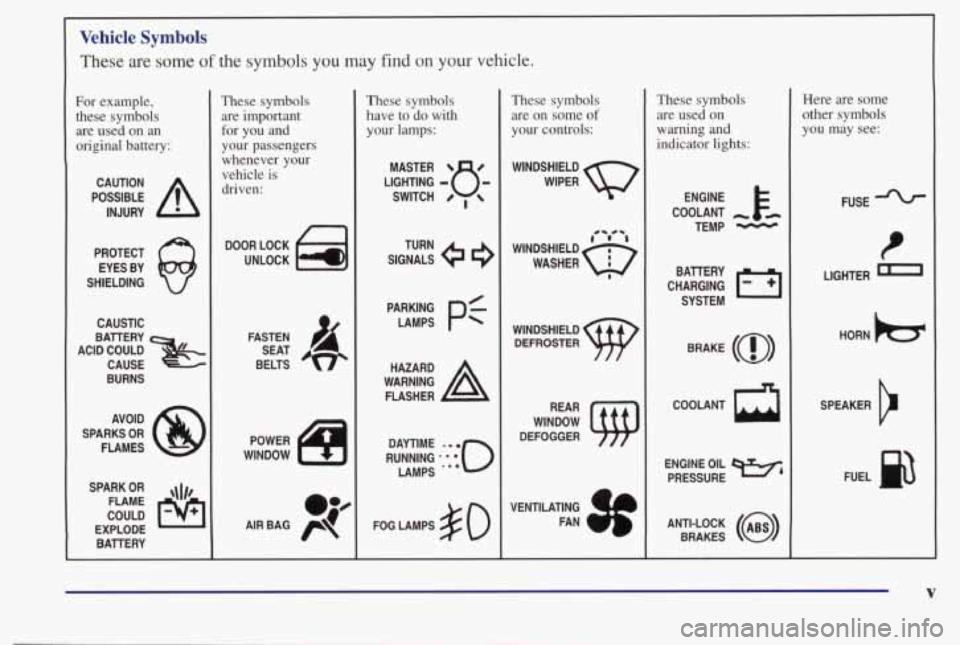
Vehicle Symbols
These are some of the symbols you may find on your vehicle.
For example,
these symbols are used on an
original battery:
POSSIBLE A
CAUTION
INJURY
PROTECT EYES BY
SHIELDING
Q
CAUSTIC
ACID COULD BAllERY
CAUSE -~~-. .
BURNS
AVOID
SPARKS
OR
FLAMES
SPARK
OR ,\I/,
COULD FLAME
EXPLODE BAllERY
I
These symbols are important
for you and
your passengers
whenever your
vehicle is
driven:
DOOR LOCK
UNLOCK
n
POWER
WINDOW
oJ4
AIR BAG p
These symbols
have to do with your lamps:
SIGNALS e3
TURN
FOG LAMPS
# 0
These symbols are on some
of
your controls:
WINDSHIELD
WIPER
WINDSHIELD
DEFROSTER
DEFOGGER
VENTILATING FAN
( rc?: A
These symbols are used on
warning
and
indicator lights:
COOLANT -
TEMP -
CHARGING I-1
BAllERY
SYSTEM
BRAKE
(a)
R
Here are some
other symbols
you may see:
FUSE
LIGHTER
n
HORN )b.
ENGINE OIL e,
PRESSURE
V
SPEAKER
b
FUEL
Page 102 of 395
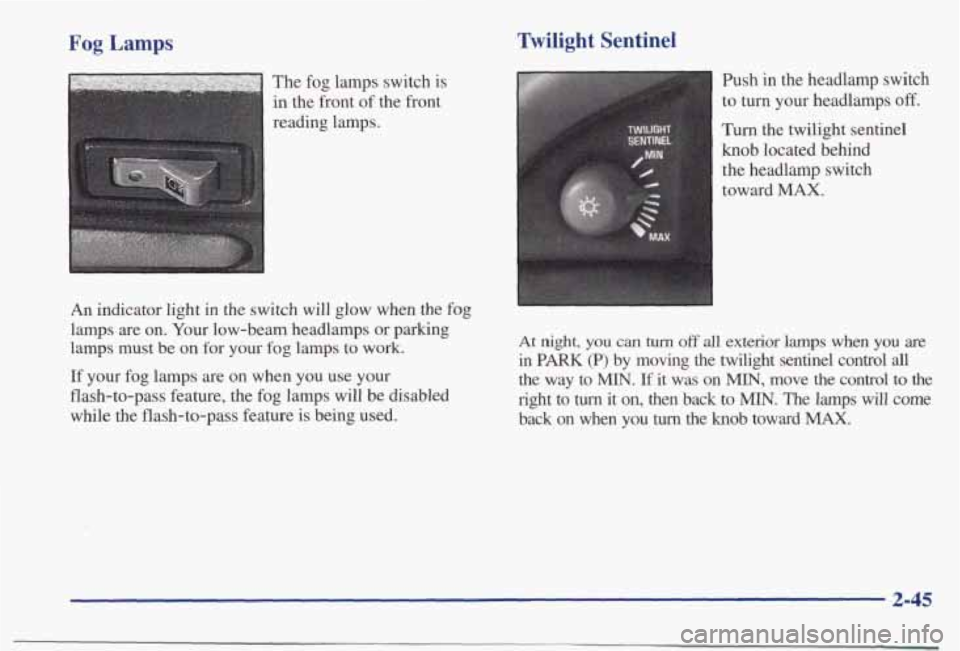
Fog Lamps
The fog lamps switch is
in the front
of the front
reading lamps.
An indicator light in the switch will glow when the
fog
lamps are on. Your low-beam headlamps or parking
lamps must be
on for your fog lamps to work.
If your fog lamps are on when you use your
flash-to-pass feature, the fog lamps will be disabled
while the flash-to-pass feature is being used.
Twilight Sentinel
Push in the headlamp switch
to turn your headlamps
off.
Turn the twilight sentinel
knob located behind
the headlamp switch
toward
MAX.
At night, you can turn off all exterior lamps when you are
in PARK (P) by moving the twilight sentinel control all
the way to MIN. If it was on MIN, move the control to the
right to
turn it on, then back to MIN. The lamps will come
back on when you
turn the knob toward MAX.
2-45
Page 139 of 395
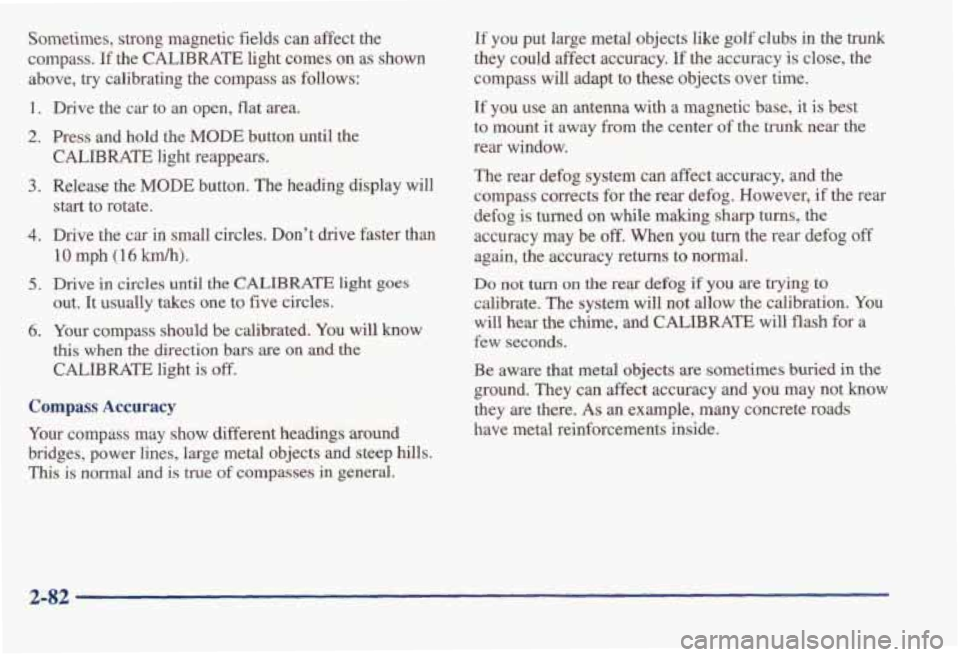
Sometimes, strong magnetic fields can affect the
compass.
If the CALIBRATE light comes on as shown
above,
try calibrating the compass as follows:
1. Drive the car to an open, flat area.
2. Press and hold the MODE button until the
CALIBRATE light reappears.
start to rotate.
3. Release the MODE button. The heading display will
4. Drive the car in small circles. Don't drive faster than
10 mph (16 km/h).
out. It usually takes one to five circles.
this when the direction bars are on and the
CALIBRATE light is off.
5. Drive in circles until the CALIBRATE light goes
6. Your compass should be calibrated. You will know
Compass Accuracy
Your compass may show different headings around
bridges, power lines, large metal objects and steep hills.
This is noma1 and is true of compasses in general.
If you put large metal objects like golf clubs in the trunk
they could affect accuracy. If the accuracy is close, the
compass will adapt to
these objects over time.
If you use an antenna with a magnetic base, it is best
to mount it away from the center of the trunk near the
rear window.
The rear defog system can affect accuracy, and the
compass corrects for the rear defog. However,
if the rear
defog is turned on while making
sharp turns, the
accuracy may be
off. When you turn the rear defog off
again, the accuracy returns to normal.
Do not turn on the rear defog if you are trying to
calibrate. The system will not allow the calibration.
You
will hear the chime, and CALIBRATE will flash for a
few seconds.
Be aware that metal objects are sometimes buried in the
ground. They
can affect accuracy and you may not know
they are there.
As an example, many concrete roads
have
metal reinforcements inside.
2-82
Page 147 of 395
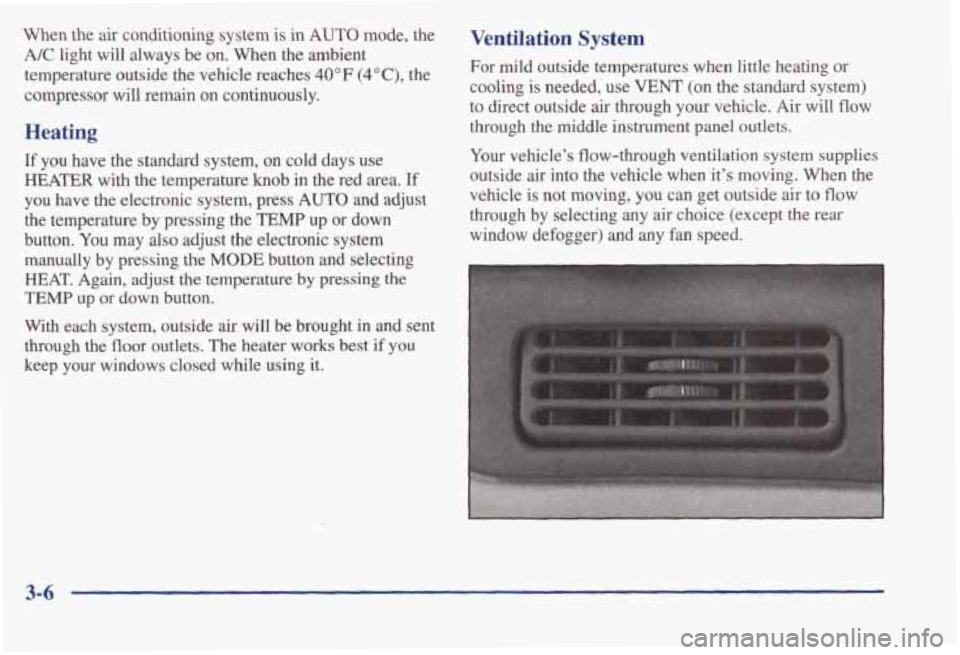
When the air conditioning system is in AUTO mode, the
A/C light will always be on. When the ambient
temperature outside the vehicle reaches
40°F (4"C), the
compressor will remain
on continuously.
Heating
If you have the standard system, on cold days use
HEAmR with the temperature
knob in the red area. If
you have the electronic system, press AUTO and adjust
the temperature by pressing the
TEMP up or down
button.
You may also adjust the electronic system
manually
by pressing the MODE button and selecting
HEAT. Again, adjust the temperature by pressing the
TEMP up or down button.
With each system, outside
air will be brought in and sent
through the floor outlets. The heater works best
if you
keep your windows closed while using it.
Ventilation System
For mild outside temperatures when little heating or
cooling
is needed, use VENT. (on the standard system)
to direct outside air through your vehicle. Air will
flow
through the middle instrument panel outlets.
Your vehicle's flow-through ventilation system supplies
outside air into the vehicle when it's moving. When the
vehicle
is not moving, you can get outside air to flow
through by selecting any air choice (except the rear
window defogger) and
any fan speed.
3-6
Page 149 of 395
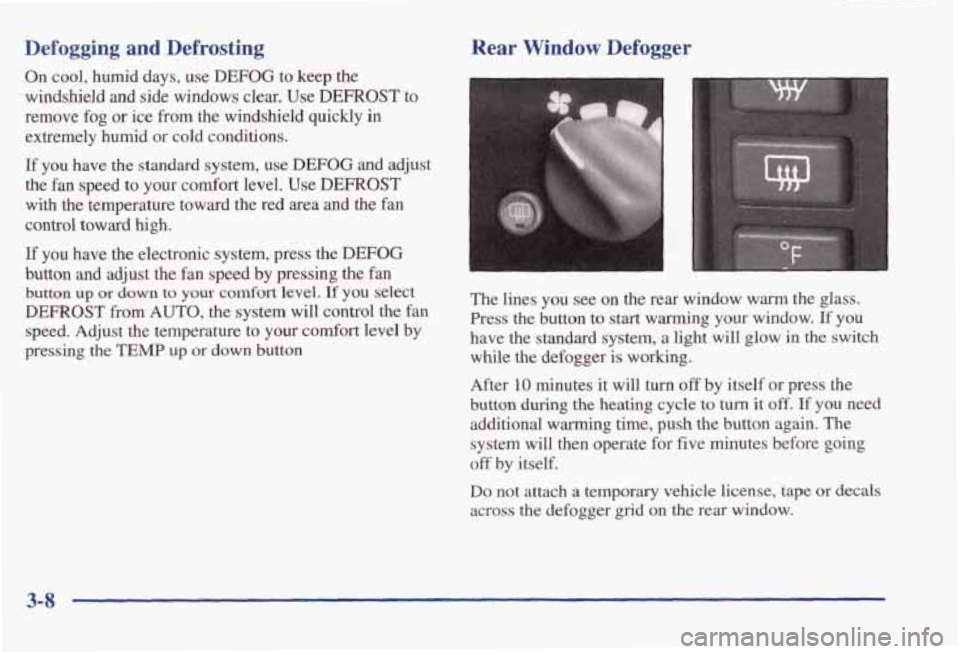
Defogging and Defrosting Rear Window Defogger
On cool, humid days, use DEFOG to keep the
windshield and side windows clear. Use
DEFROST to
remove fog or ice from the windshield quickly
in
extremely humid or cold conditions.
If you have the standard system, use DEFOG and adjust
the fan speed to your comfort level. Use
DEFROST
with the temperature toward the red area and the fan
control toward high.
If you have the electronic system, press the
DEFOG
button and adjust the fan speed by pressing the fan
button up or down to your comfort level. If you select
DEFROST from AUTO, the system will control the fan
speed. Adjust the temperature to your comfort level by
pressing the TEMP up or down button The lines
you see on the rear window warm the glass.
Press the button to start warming your window. If you
have the standard system,
a light will glow in the switch
while the defogger
is working.
After
10 minutes it will turn off by itself or press the
button
during the heating cycle to turn it off. If you need
additional warming time, push the button again. The
system will
then operate for five minutes before going
off by itself.
Do not attach a temporary vehicle license, tape or decals
across the defogger grid on the rear window.
3-8
Page 312 of 395
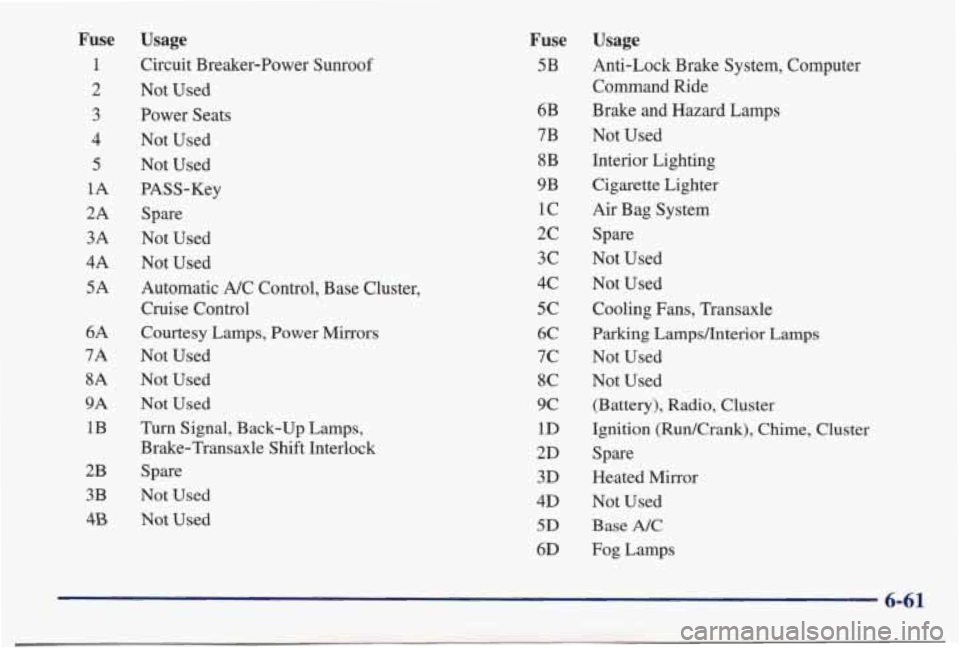
Fuse
1
2 3
4
5
1A
2A
3A
4A
5A
6A
7A
8A
9A
1B
2B
3B
4B
Usage
Circuit Breaker-Power Sunroof
Not Used
Power Seats
Not Used
Not Used
PASS-Key
Spare
Not Used
Not Used
Automatic A/C Control, Base Cluster,
Cruise Control
Courtesy Lamps, Power Mirrors
Not Used
Not Used
Not Used
Turn Signal, Back-up Lamps,
Brake-Transaxle Shift Interlock
Spare
Not Used
Not Used
Fuse Usage
5B Anti-Lock Brake System, Computer
6B
7B 8B
9B
1c
2c
3c
4c
5c 6C
7c
8C
9c
1D
2D
3D
4D
5D
6D
-
Command Ride
Brake and Hazard Lamps
Not Used
Interior Lighting
Cigarette Lighter
Air Bag System Spare
Not Used
Not Used
Cooling Fans, Transaxle
Parking Lampshterior Lamps
Not Used
Not Used
(Battery), Radio, Cluster
Ignition (RudCrank), Chime, Clu
Spare
Heated Mirror
Not Used
Base
NC
Fog Lamps
ste :r
Page 377 of 395
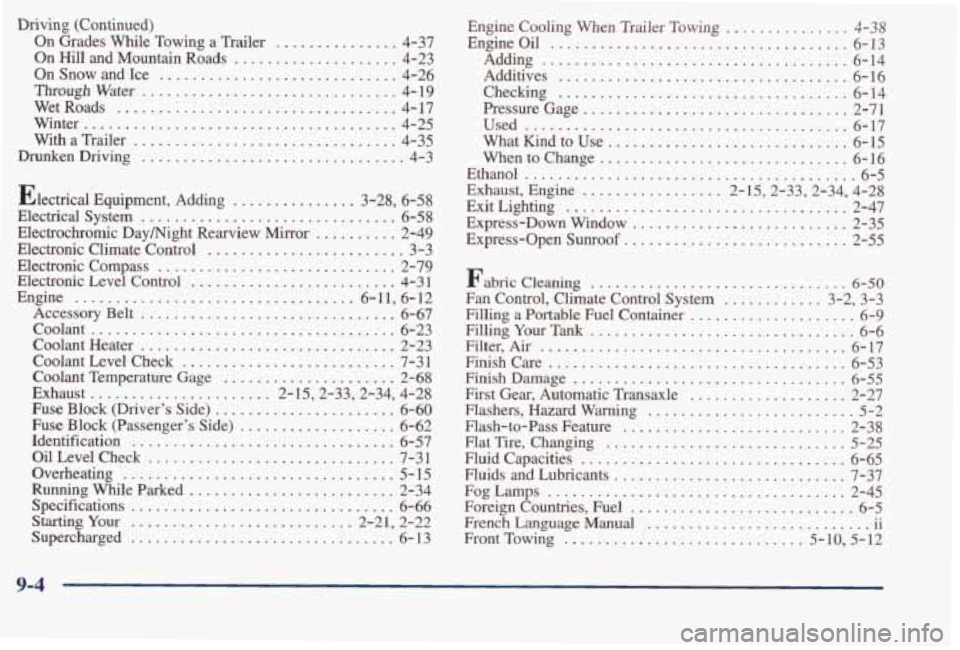
Driving (Continued) On Grades While Towing a Trailer
............... 4-37
On Hill and Mountain Roads
.................... 4-23
On Snow and Ice
............................. 4-26
ThrmrghWatm ............................... 4-19
WetRoads
.................................. 4-17
Winter
...................................... 4-25
With a Trailer
................................ 4-35
Drunken Driving
................................ 4-3
Electrical Equipment. Adding
............... 3.28. 6.58
Electrical System
............................... 6-58
Electrochromic Daymight Rearview Mirror
.......... 2-49
Electronic Climate Control
........................ 3-3
Electronic Compass
............................. 2-79
Electronic Level Control
......................... 4-31
Engine .................................. 6.11. 6.12
Accessory Belt
............................... 6-67
Coolant
..................................... 6-23
Coolant Heater
............................... 2-23
Coolant Level Check
.......................... 7-31
Coolant Temperature Gage
..................... 2-68
Exhaust ...................... 2-15.2-33.2-34. 4-28
Fuse Block (Driver’s Side)
...................... 6-60
Fuse Block (Passenger’s Side) ................... 6-62
Oil Level Check .............................. 7-31
Overheating
................................. 5- 15
Running While Parked ......................... 2-34
Specifications
................................ 6-66
StartingYour ...........................2-21. 2-22
Identification
................................ 6-57
Supercharged
................................ 6-13 Engine Cooling When Trailer
Towing ............... 4-38
Engine Oil .................................... 6-13
Adding
..................................... 6-14
Pressure Gage
................................ 2-71
What
Kind to Use ............................. 6-15
When to Change
.............................. 6-16
Ethanol
........................................ 6-5
Exhaust. Engine
................. 2-15.2-33.2-34. 4-28
Express-Down Window
.......................... 2-35
Express-Open
Sunroof ........................... 2-55
Additives
................................... 6-16
Checking ................................... 6-14
Used ....................................... 6-17
ExitLighting
.................................. 2-47
Fabric Cleaning ............................... 6-50
Fan Control. Climate Control System ............ 3-2. 3-3
Filling a Portable Fuel Container
.................... 6-9
FillingYourTank
................................ 6-6
Finishcare
.................................... 6-53
First Gear, Automatic Transaxle
................... 2-27
Flashers.
Hazard Warning ......................... 5-2
Flash-to-Pass Feature ........................... 2-38
Flat Tire. Changing ............................. 5-25
Fluid Capacities
................................ 6-65
Fluids and Lubricants
............................ 7-37
Fog Lamps .................................... 2-45
Foreign Countries, Fuel
........................... 6-5
French Language
Manual ........................... ii
Front Towing
............................. 5-10. 5-12
Filter.
Air ..................................... 6-17
FinishDamage
................................. 6-55
9-4